Residence permits - statistics on stock of valid permits at the end of the year
Data extracted: 24 November 2023.
Planned article update: 12 September 2024.
Highlights
At the end of 2022, there were 24.0 million valid residence permits held by non-EU citizens in the EU.
At the end of 2022, family reunification accounted for 34.9 % of valid residence permits held by non-EU citizens in the EU.
Moroccan (2.0 million), Turkish (1.9 million) and Ukrainian (1.4 million) citizens were the three main groups of citizenship holding valid residence permits in the EU at the end of 2022.
Stock of valid residence permits in the top four EU Member States, 2016–2022
This article presents European Union (EU) statistics [1] on the stock of valid residence permits granted to non-EU citizens [2], also known as third country nationals.
A residence permit in the EU represents an authorisation valid for at least three months issued by a competent authority allowing non-EU citizens to stay legally on its territory. Data on residence permits are collected with information on the reason for issuing the permit. The main reasons are family, employment, education and other (including refugee status and subsidiary protection).
This article provides an overview of the stock – at the end of 2022 – of valid residence permits granted to non-EU citizens. In addition, it presents the developments of the stock between the end of 2016 and the end of 2022. Different aspects are analysed, such as the reasons for issuing the permits, the duration of permits and the citizenship of persons to whom the permits were granted.
Note that a complementary article provides information on the number of first residence permits issued during the year. This article does not include information on temporary protection of refugees from Ukraine in EU Member States resulting from Russia's military aggression against that country.
Full article
Non-EU citizens with a valid residence permit
At the end of 2022, there were 24.0 million valid residence permits granted to non-EU citizens permitting them to reside in the EU [3]. Malta (168 permits per 1 000 people), Latvia and Estonia (142) along with Cyprus (130) were the EU Member States where the highest number of non-EU citizens held valid residence permits relative to the EU Member State’s population (see Map 1). Germany (5.4 million valid permits), France (3.9 million), Italy (3.8 million) and Spain (3.6 million) together accounted for 69.9 % of the valid residence permits granted to non-EU citizens.
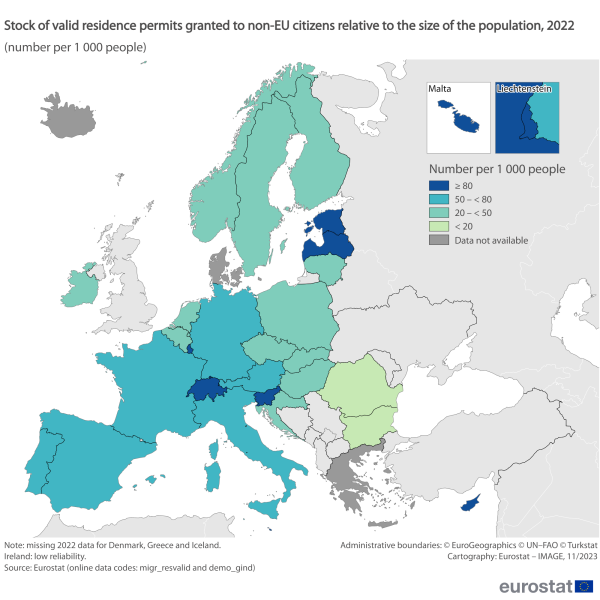
(number per 1 000 people)
Source: Eurostat (migr_resvalid) and (demo_gind)
Stock of residence permits granted to non-EU citizens at the end of 2022
The stock of valid residence permits granted to non-EU citizens to reside in the EU increased by 7.8 % between the end of 2021 and the end of 2022 (see Figure 1). Among the 25 EU Member States for which data are available, 22 reported an increase in the stock of permits. The highest rate of increase was recorded in Malta where the stock of permits granted to non-EU citizens increased by 43.8 %, followed by Ireland (up 37.9 %) and Lithuania (up 33.0 %). Among the four EU Member States with the largest stocks of resident permits, Germany recorded the highest increase, as the number of valid permits rose by 16.8 % between the end of 2021 and the end of 2022; increases were also recorded in Italy (up 7.8 %), France (up 5.5 %) and Spain (up 5.1 %). In contrast, there was a reduction in the stock of valid permits granted to non-EU citizens in three EU Member States: down 2.3 % in Hungary, 3.6 % in Latvia and 8.2 % in Sweden.
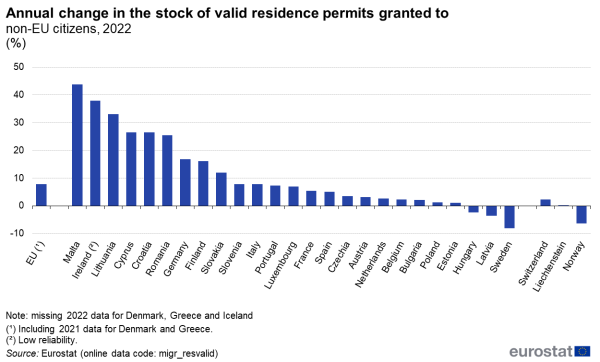
(%)
Source: Eurostat (migr_resvalid)
Figure 2 provides an analysis of the reasons for which residence permits were granted. At the end of 2022, more than one third (34.9 %) of all residence permits granted to non-EU citizens were for family-related reasons, with lower shares for employment reasons (19.6 %), refugee status and subsidiary protection (15.1 %) or education reasons (3.9 %). Residence permits classified under the heading ‘other reasons’ accounted for 26.5 % of all valid permits; note that this includes the stock of permits granted for residence only (for example, a pensioner), permits granted for humanitarian reasons under national law (outside those covered by the heading of ‘refugee status and subsidiary protection’ under international law) including permits for unaccompanied minors or victims of human trafficking, as well as permits granted to long-term or permanent residents.
A more detailed analysis of the situation in each EU Member State at the end of 2022 reveals that more than half of all the valid residence permits granted to non-EU citizens in Belgium (57.8 %) were family-related while this share was slightly lower in Luxembourg (49.0 %), Italy (48.0 %) and Sweden (47.7 %). Germany (2 million) and Italy (1.8 million) recorded the highest absolute numbers of permits issued for this reason.
More than half of the stock of valid residence permits for non-EU citizens at the end of 2022 was granted for employment reasons in Croatia (72.5 %), Malta (68.6 %), Slovakia (57.5 %), Poland (56.6 %) and Hungary (52.1 %). In absolute terms, Italy registered the highest number of valid residence permits for employment reasons (1.6 million), considerably greater than in Poland (547 143) where the second highest number was observed.
In Germany, refugee status and subsidiary protection accounted for close to half (47.2 %) of all valid residence permits issued to non-EU citizens at the end of 2022, with Sweden (26.5 %), Belgium (15.6 %), Finland (14.7 %), the Netherlands (13.1 %), France (12.0 %), Luxembourg (11.9 %) and Cyprus (10.6 %) also recording double-digit shares. In absolute terms, Germany granted the highest number of valid residence permits to non-EU citizens for refugee status and subsidiary protection (2.6 million), followed by France (472 084), Italy (126 433), Sweden (125 318), the Netherlands (102 204) and Belgium (78 449).

(% share of total number of permits)
Source: Eurostat (migr_resvalid)
At the end of 2022, the distribution of valid residence permits at EU level granted to non-EU citizens indicates that 93.0 % were valid for 12 months or more, compared with 5.7 % valid for 6 to 11 months and 1.3 % valid for 3 to 5 months (see Figure 3). This predominance of permits valid for at least 12 months was observed across all the EU Member States. The share of residence permits valid for 12 months or longer, for 2022 available data, ranged from 53.9 % in Croatia, 56.0 % in Poland and 65.2 % in Ireland up to 99.8 % in Estonia. Poland recorded the highest share of residence permits with a validity period of 6 to 11 months, accounting for 42.9 %. Meanwhile, Belgium had the highest percentage of residence permits valid for 3 to 5 months, at 4.2 %.
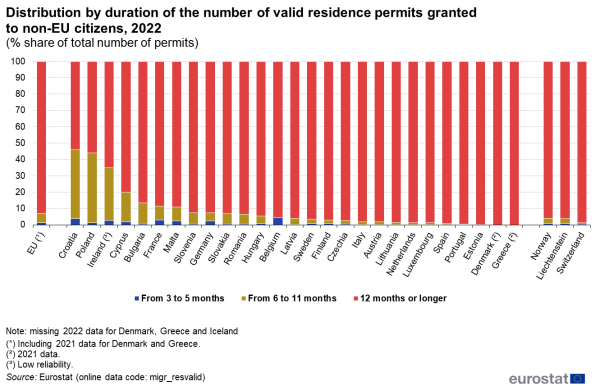
(% share of total number of permits)
Source: Eurostat (migr_resvalid)
Developments for the stock of residence permits
Across the EU, there was an increase of 34.8 % between the end of 2016 and the end of 2022 in the stock of residence permits granted to non-EU citizens. The most rapid increases were recorded for residence permits granted for refugee status or subsidiary protection status, from 1.1 million to 3.6 million (see Figure 4). Note that the time series studied starts just after the large increase in the stock of permits related to refugee and subsidiary protection status recorded between 2015 and 2016, which was linked to events in Syria: in recent years large numbers of asylum seekers from this country were recorded, as well as first instance and final positive decisions on applications from Syrian citizens [4]. Smaller increases were recorded between the end of 2016 and the end of 2022 for employment reasons up 69.2 %, up 44.9 % for education reasons, up 21.3 % for family reasons and down 0.1 % for other reasons.
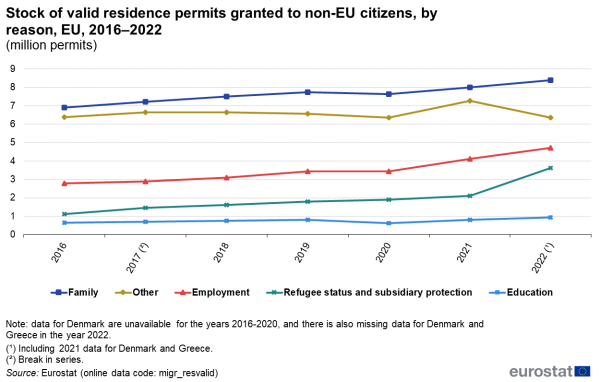
(million permits)
Source: Eurostat (migr_resvalid)
Figure 5 presents developments among the four EU Member States that granted the largest number of permits between the end of 2016 and the end of 2022. In Germany, the stock of valid residence permits initially increased each year, from 4.1 million in 2016 to 4.9 million in 2019. The number dropped back in 2020 to 4.2 million but partially rebounded in 2021 to reach 4.6 million and increased further to 5.4 million in 2022. In France, the number of valid permits rose every year, from 2.7 million in 2016 to 3.9 million in 2022; a similar situation was observed in Spain, up from 2.6 million in 2016 to 3.6 million in 2022. The development in Italy was somewhat different, the number of valid residence permits remaining relatively stable between 2016 (3.7 million) and 2019 (3.6 million), before dipping down to 3.4 million in 2020, increasing to 3.6 million in 2021 and then further increasing to 3.8 million in 2022.

(million permits)
Source: Eurostat (migr_resvalid)
Between the end of 2016 and the end of 2022, the increase in the stock of residence permits granted to non-EU citizens in the EU was influenced, as noted above, by a rapid rise in the number of permits granted to persons benefiting from refugee or subsidiary protection status. Figure 6 underlines that most of the absolute increase resulted from permits granted to refugees, the stock of their permits rising from 0.8 million at the end of 2016 to 2.2 million by the end of 2022.
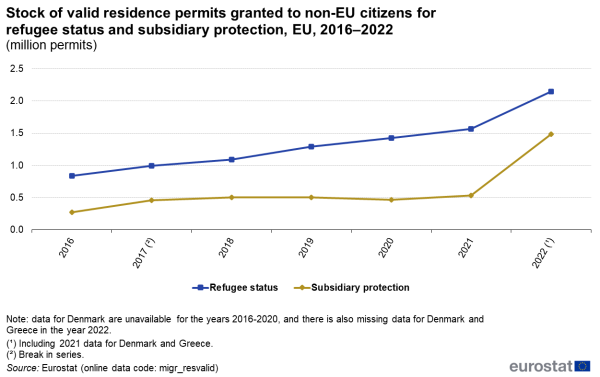
(million permits)
Source: Eurostat (migr_resvalid)
Citizenship of the permit holders
Map 2 provides an overview of the countries of citizenship of the holders of valid residence permits in the EU (over 100 000 permits) at the end of 2022. The stock of residence permits was highest for citizens of Morocco (2.0 million) and Türkiye (1.9 million), followed by citizens of Ukraine (1.4 million) and China (more than 1 million). These were the only countries whose citizens held more than one million valid residence permits. The next highest numbers were recorded for citizens of Syria (956 311), Albania (937 136), the United Kingdom (857 811), Russia (816 018), India (751 267) and Algeria (741 585). By the end of 2022, citizens of these 10 countries accounted for 48.9 % of the total stock of permits among non-EU citizens holding valid residence permits in the EU.

(number of permits)
Source: Eurostat (migr_resvalid)
Table 1 provides a more detailed analysis for the top 10 countries with the highest stock of permits (as identified above). It shows that more than five sixths (84.6 %) of all valid residence permits held by Algerian citizens were reported by France, while Germany reported close to three quarters (71.0 %) of valid permits held by Syrian citizens in the EU and more than two thirds (66.9 %) of those held by Turkish citizens. The next highest shares of valid residence permits were observed for British citizens in Spain (48.0 %), Albanian citizens in Italy (43.2 %), for Ukrainian citizens in Poland (31.1 %) and for Moroccan citizens in Spain (also 40.9 %).
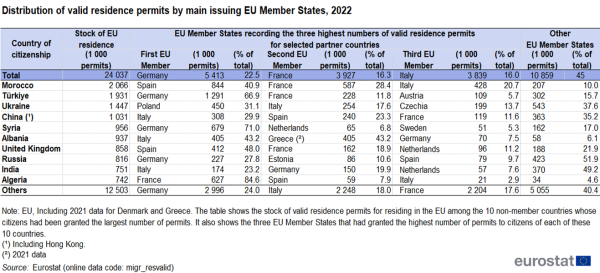
Source: Eurostat (migr_resvalid)
Developments for residence permits by citizenship and by reason
For several of the top 10 countries of citizenship of the permit holders, between the end of 2016 and the end of 2022 there was a clear change in the stock of valid residence permits (see Figure 7), in some cases interrupted in 2020, at least in part related to the COVID-19 pandemic.
- The stock of valid residence permits for India, Syria, Ukraine and Russia all recorded relatively large increases over much of this period, although the number of Ukrainian citizens dropped off in the last year.
- China (including Hong Kong), Algeria and Morocco recorded relatively low increases; among these three countries, the drop in 2020 was most notable for Chinese citizens.
- The number of Albanian citizens with valid residence permits changed little during this period.
- The only one of these top 10 countries with a smaller number of citizens with a valid residence permit in 2022 than in 2016 was Türkiye.
- The situation for the United Kingdom was unique, related to its withdrawal from the EU on 31 January 2020. By definition, there were no valid residence permits for British citizens as of the end of 2019 and only a small number at the end of 2020 when the transition period related to the United Kingdom’s withdrawal ended. Consequently, the stock of residence permits increased substantially in 2021 and 2022.
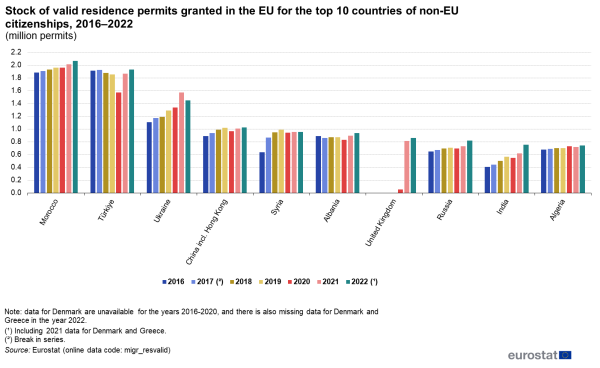
(million permits)
Source: Eurostat (migr_resvalid)
For the top 10 non-EU countries whose citizens had, at the end of 2022, the highest numbers of valid permits to reside in the EU, Figure 8 provides a more detailed analysis according to the reasons for which the permits were granted. Among Albanian citizens with a valid residence permit in the EU at the end of 2022, 51.1 % had a permit granted for family-related reasons. As with citizens of Albania, family was also the principal reason for granting residence permits in the EU to citizens of Morocco (46.4 %), China (including Hong Kong; 34.5 %) and Russia (37.6 %). Employment-related reasons were predominant among Ukrainians (48.6 %) and Indians (42.4 %), while most citizens from Syria with a valid residence permit (79.4 %) had a permit granted for reasons related to their refugee or subsidiary protection status together with citizens of Türkiye (38.7 %). Citizens of the United Kingdom (81.6 %) and Algeria (49.1 %) with valid residence permits mainly benefited from residence permits granted for other reasons.
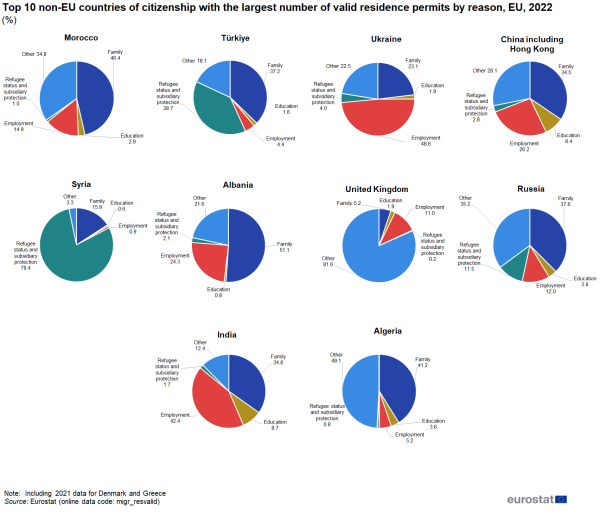
(%)
Source: Eurostat (migr_resvalid)
Source data for tables and graphs
Data sources
The data used in this article – based entirely on administrative sources – are supplied to Eurostat as part of an annual residence permits data collection exercise according to the requirements of Article 6 of Regulation (EC) No 862/2007 on Community statistics on migration and international protection. Commission Regulation (EU) No 216/2010 on Community statistics on migration and international protection, as regards the definitions of categories of the reasons for issuing residence permits, provides the list and definition of reasons for residence permits being issued.
Since the 2008 reference year, Eurostat has collected data on permits that have been granted to nationals of non-member countries to reside in the EU. Data on residence permits may be analysed by:
- reporting country – the EU Member State (or EFTA country) granting the residence permit;
- citizenship of the permit holder;
- reason for the permit being issued – family formation and reunification; education and study; remunerated activities (employment); refugee status; subsidiary protection status; other reasons;
- the length of validity of the permit – for at least three months but less than six months; for at least six months but less than 12 months; for 12 months or longer.
Statistics on residence permits are available as both stocks and flows. Data on stocks relate to all valid residence permits at the end of the reference year, in other words, the total stock of residence permits including renewed permits.
It should be noted that certain methodological aspects are not fully harmonised between the reporting countries due to different legal and/or information technology systems. Therefore, the results that are presented in this article should be interpreted with care and readers are advised to make reference to the metadata file on residence permits statistics.
The "u" flag in Irish stock residence permit data highlights limited data quality reported by the Irish authorities. For the process of generating resident permits data that involves both the Irish Police and the Department of Justice an old information system is currently being used. The current system's limitations, which misses unique identifier of persons, require manual data checks, which may lead to potential quality issues. According to Irish authorities a comprehensive modernization program of the information systems to ensure more accurate data management is in progress.
Context
Migration policies within the EU are built upon solidarity and responsibility, taking account of the contribution that immigrants make to the EU’s economic development and performance. Within the European Commission, the Directorate-General for Migration and Home Affairs is responsible for immigration policy.
EU policy measures on legal immigration cover the conditions of entry and residence for certain categories of immigrants. The Single Permit Directive (2011/98/EU) establishes rules for a single application/permit and equal treatment provisions for non-EU citizens. The legislation does not apply to certain categories of non-EU citizens, such as highly qualified workers subject to the ‘EU Blue Card Directive’, some students, or various persons working temporarily (for example, as seasonal workers or au pairs), or to migrants who have lived in the EU for at least five years and have applied and been granted long-term residence status, as defined in Council Directive 2003/109/EC concerning the status of third-country nationals who are long-term residents. Equally, the legislation concerning the Single Permit Directive does not apply in Denmark or Ireland (each of which has special arrangements for immigration and asylum policy).
All relevant legal acts and information regarding the EU’s immigration policy can be accessed on the European Commission’s website.
For more information on the European Commission's plans to develop a fairer, more European approach to managed migration, please refer to the New Pact on Migration and Asylum. The new pact seeks to build a complete system by providing essential new tools for faster and more integrated procedures, a better management of Schengen and external borders, and flexibility and crisis resilience. It also focuses on legal migration and integration.
Notes
- ↑ Data are based on Article 6 of Regulation (EC) No 862/2007 on migration and international protection statistics. National administrative registers and databases are the main sources for these statistics.
- ↑ Non-EU citizens: defined as persons without citizenship of an EU Member State.
- ↑ Note that all of the statistics presented in this article for the 2022 EU data include 2021 data for Denmark and Greece (2022 data for these two countries are not yet available). Moreover, time series from 2016 to 2021 have missing data for Denmark.
- ↑ Please consult the datasets: asylum applicants by type of applicant, citizenship, age and sex, first instance decisions on applications by citizenship, age and sex and final decisions in appeal or review on applications by citizenship, age and sex.
Direct access to
Asylum
- Asylum applications - annual statistics
- Statistics on countries responsible for asylum applications (Dublin Regulation)
Migration
- Enforcement of immigration legislation statistics
- Migrant integration statistics
- Migration and migrant population statistics
Residence permits
- Residence permits (migr_res)
- Residence permits by reason, length of validity and citizenship (migr_resval)
- First permits by reason, length of validity and citizenship (migr_resfirst)
- First permits issued for family reasons by reason, length of validity and citizenship (migr_resfam)
- First permits issued for education reasons by reason, length of validity and citizenship (migr_resedu)
- First permits issued for remunerated activities by reason, length of validity and citizenship (migr_resocc)
- First permits issued for other reasons by reason, length of validity and citizenship (migr_resoth)
- Change of immigration status permits by reason and citizenship (migr_reschange)
- All valid permits by reason, length of validity and citizenship on 31 December of each year (migr_resvalid)
- Long-term residents by citizenship on 31 December of each year (migr_reslong)
- Single permits issued by type of decision, length of validity (migr_ressing)
- Long-term residents among all non-EU citizens holding residence permits by citizenship on 31 December (%) (migr_resshare)
- Long-term residence permits issued during the year (migr_resltr)
- First permits issued for family reunification with a beneficiary of protection status (migr_resfrps1)
- Permits valid at the end of the year for family reunification with a beneficiary of protection status (migr_resfrps2)
- Residence permits by reason, age, sex and citizenship (migr_resage)
- First permits by reason, age, sex and citizenship (migr_resfas)
- All valid permits by age, sex and citizenship on 31 December of each year (migr_resvas)
- Long-term residents by age, sex and citizenship on 31 December of each year (migr_reslas)
- EU blue cards (migr_resbcard)
- EU blue cards by type of decision, occupation and citizenship (migr_resbc1)
- Admitted family members of EU blue card holders by type of decision and citizenship (migr_resbc2)
- EU blue card holders and family members by EU Member State of previous residence (migr_resbc3)
- Residence permits for intra-corporate transfer (migr_resictra)
- Intra-corporate transferee permits issued, renewed and withdrawn by type of permit, length of validity and citizenship (migr_resict1_1)
- Intra-corporate transferee permits issued by type of permit, economic sector and citizenship (migr_resict1_2)
- Intra-corporate transferee permits issued by type of permit, length of validity, transferee position and citizenship (migr_resict1_3)
- Authorisation for the purpose of the seasonal work (migr_resseaw)
- Authorisations for the purpose of seasonal work by status, length of validity, economic sector and citizenship (migr_ressw1_1)
- Authorisations issued for the purpose of seasonal work by economic sector, sex and citizenship (migr_ressw2)
- Residence permits - Students and Researchers (migr_ressr)
- Authorisations for study and research by reason, type of decision, citizenship and length of validity (migr_ressrath)
- Residence permits by reason, length of validity and citizenship (migr_resval)
- Residence permits (ESMS metadata file – migr_res_esms)